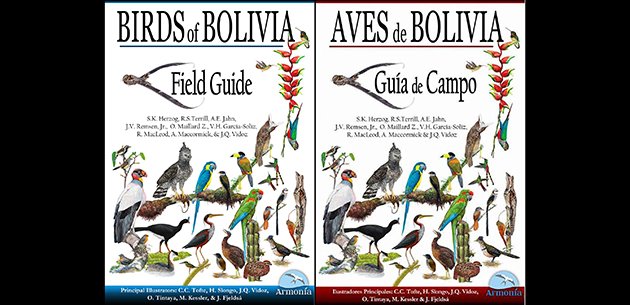
One of these days, Jeopardy will feature a category called “Field Guides” and the first clue will be: “This landlocked South American country finally got its own bird field guide in 2016, but it wasn’t available in the United State until 2019.” The answer, as discerning Neotropical birders know, is: “What is Bolivia?”
The book in question is Birds of Bolivia: Field Guide, edited and written by Sebastian K. Herzog and a team of Bolivian, American, British, and Argentinian ornithologists; illustrated by a group of Danish, Argentinian, Bolivian, Peruvian, Brazilian, and Italian artists, published in Bolivia in 2016 in both English and Spanish-language editions, and republished in July 2019 in slightly revised form for distribution in the United States (English-language edition only). Over 14 years in development, the guide is a triumph, not only for its landmark status as the first field guide to birds for Bolivia, a landlocked country that features great diversity of habitat, but for figuring out a publishing mechanism that bypasses commercial publishers and routes profits back into the Bolivian economy for conservation and sustainable development.
Plate 97: Andean and partly Andean antshrikes, illustrated by Oscar Tintaya
Bolivia doesn’t come up much in discussions of birding travel. Like a shy stepchild, it’s always eclipsed by the wonders of Brazil, Ecuador, Colombia, etc. (Even 10,000 Birds has had happenstance coverage of this country, the most specific post being Corey’s account of a Simpsons episode about the fictional Bolivian Tree Lizard.) I’m not sure if this is because the country lacks an ocean or because, until recently, it lacked good roads and an eco-travel hospitality infrastructure. Its geographic diversity is impressive even without ocean-front property: there’s the Andes in the southwest, the Pantanal spilling over from Brazil in the northeast, the Llanos plains in the east, and ecological niches with tantalizing names such as Amazonian rainforest, Chaco savannah, Cerrado, Yungas cloud forest, Dry Puna, and Humid Puna (the latter two being the two main ecosystems of the Andes in the country).
Diversity of habitat means, of course, great biodiversity, and the Introduction boasts that Bolivia “is the richest landlocked nation on Earth for bird diversity, the sixth richest overall, and the fifth richest in the Americas” (p. 10). That’s pretty amazing–Bolivia has more bird species than India! The source of this ranking, BirdLife International, lists Bolivia as currently having 1,439 bird species, including 18 breeding endemics. The guide covers 1,433 species, the number of birds documented at the end of 2014, the cutoff point for the book. This is more than eBird reports–a checklist generated from the citizen science database lists only 1,413 species. Clearly, this is an under-birded country.
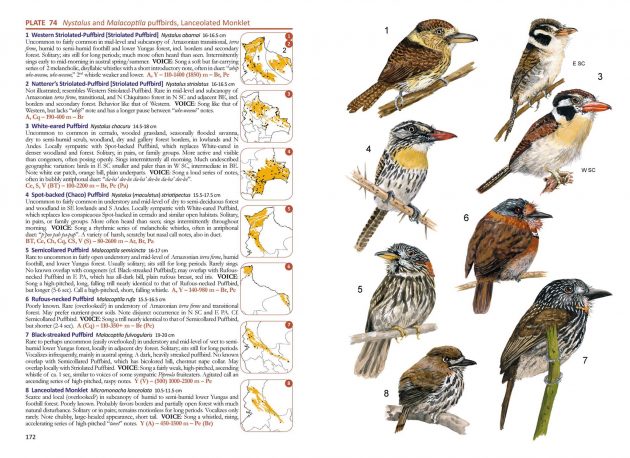 Plate 74: Nystalus and Malacoptila puffbirds, Lanceolated Monklet, illustrated by Michael Kessler
Plate 74: Nystalus and Malacoptila puffbirds, Lanceolated Monklet, illustrated by Michael Kessler
Despite the many species covered, Birds of Bolivia never feels cramped for space. The fairly large size (6.5″ x 9.5″x 1.25″) allows for large images, especially on plates like the one of Puffbirds (above), by Michael Kessler, showing six to eight birds. There are more birds per page shown for species that are sexually dimorphic, like the Andean Long-tailed Hummingbirds and Pufflegs illustrated by Carl Tofte (below), but there is still plenty of room to show gender and even subspecies differences. The downside of the size (and quality of paper) is that this is a fairly heavy book, about 2.5 pounds, at least for me. Talking to other birders about field guide size and weight, I’ve realized that what doesn’t work for me is not a problem for other birders, so just keep in mind that the guide weighs about as much as a DSLR camera, minus lens. I need to add that the binding is not great. I can see the glue when I open the cover and feel like it will tear off if I hold the book the wrong way. Sadly, binding appears to be a problem everywhere (I just retrieved a field guide published by Lynx Edicions from my bookshelf, and the spine impaled on itself).
Plate 62: Andean long-tailed hummingbirds and pufflegs, illustrated by Carl Christian Tofte
More on Species Accounts
In what has become the modern-day traditional method of organization, species are listed and described on the left-hand page and illustrative plates are on the right. Almost all 1,433 covered in the Species Accounts are illustrated; the two exceptions are Common Tern and Arctic Tern, vagrants. Coverage of subspecies and color morphs includes most birds “sufficiently distinctive to be recognized the field,” but Herzog apologetically states in the Introduction that “a handful” of these and the terns could not be included due to time constraints (p.11). Numbers are used to match text description to illustration, with symbols used to denote male and female, abbreviations used for adult and immature, and scientific name for subspecies. I do wish the birds’ names were used on the illustration plates instead of numbers; there is certainly enough space to do it. But, the numbers are quite large, and the birds organized in groupings that, for the most part, make it an easy process to figure out which Antwren (or Woodcreeper or Seedeater) is which.
Species are organized (with some exceptions) according to the June 2016 edition of the South American Classification Committee (SACC) of the American Ornithologists’ Union. Common and scientific names are also based on the SACC. This isn’t surprisingly considering that co-author J. Van Remsen, Jr. of Louisiana State University is a long-time member and currently Acting Chair of the SACC. However, the authors have come up with a taxonomic feature that expands the scope of taxonomic information that I haven’t seen in any other field guide: notes on (a) “splits, lumps, or nomenclatural changes” accepted by the three other major taxonomic systems (IOC World Bird List, Clements Checklist of Birds of the World, and Birdlife International) but not by SACC; (b) recently proposed “splits or nomenclatural changes” accepted by SACC but not by at least one of the other three; (c) taxonomic changes currently being proposed and likely to be accepted by SACC. The notes are indicated by a system of parentheses, brackets, and braces.
This is incredibly helpful, especially if you are using eBird (Clements), Xeno-Canto (IOC), Handbook of the Birds of the World Alive (Birdlife International) or other popular birding apps and websites that rely on one of the four major taxonomic systems. Or, if you’re like me and can’t remember that Slate-throated Redstart is Slate-throated Whitestart in certain (IOC) circles. It can take a bit of research to figure these notes out, especially when they are citing taxonomic differences (Riparian [Blackish] Antbird, for example, is treated differently in three of the four taxonomic systems), but it is tremendously helpful just to know that there is an issue to be researched.
Another helpful innovation is denoting species whose presence is not totally certain with asterisks. These are species which have been seen one or two or three times, but the rare sightings were unsupported by documentation. The authors obviously decided to err on the side of comprehensiveness, and though an argument could be made that these species are better situated in an appendix, including them in the Species Accounts allows a puzzled birder to easily consider the species as a possibility.
Plate 124: Thornbirds, Creamy-breasted and Berlepsch’s canasteros, illustrated by Héctor Slongo
Species Accounts are smartly designed, utilizing font color and size to organize information and help the user quickly find it. Plate number and a brief description of species are printed at the top of the left-hand page in a bright brown, and the first line of each account–common and scientific names and measurements–are printed in purple, common name bolded and scientific name in italics. Voice descriptions are labelled ‘VOICE’ and habitat codes are in the brown of the page headings. Distribution maps are set off in ovoid squares, colored in brown and purple. Each species is numbered, with the numbers referring to the illustrations on the right. The overall effect is one of elegant utility; this is a field guide that is a pleasure to look at while you are using it.
The text of each species account succinctly summarizes the basics in 6 to 15 lines–common name; scientific name, measurements; IUCN Red List status if endangered or vulnerable; relative abundance in Bolivia (common, uncommon, rare, etc.); habitat; distinct behavior useful for identification; significant plumage and other visual features important for identification, especially for differentiation from similar species; voice. Measurements veer off from the typical tip-of-bill to tip-of-tail; here the length is base-of-bill to tip-of-tail, utilizing figures Herzog obtained from museum specimens and other sources. Bill length is given separately for Toucans and Hummingbirds, based on the reasoning that it’s an important identification feature for the first and an important identification feature for the second, but not for kingfishers or woodpeckers. Wingspan measurements are given for raptors on the ‘raptors in flight’ pages.
The text descriptions are excellent, especially when describing behavior. Blue-mantled Thornbill “gleans insects from foliage and licks secretions of tiny cicadas and aphids while clinging to vegetation, often fluttering wings” (p. 152). Hazel-fronted Pygmy-Tyrant is “best detected by dry, snapping wing sounds” (p. 300). Vocalization descriptions are exceptionally detailed, giving descriptions of sound, pacing, number of syllables, and how these differ from similar bird songs. The song of the Amazonian Antshrike, for example, is “an even pitched, fast (9-11 noes/sec), slightly accelerating series of hollow, popping notes that get louder; occ. slightly rising-falling in pitch and pace. Cf. [compare to] Masked Antpitta….” (p. 218). Despite the number of contributors, the level of detail and excellence is consistent throughout the guide.
Habitat Codes and Distribution Maps
A lot of attention is given to habitat, which is appropriate considering the range of geographic areas and climate in Bolivia. In addition to textual descriptions, the authors have divided Bolivia into 12 ecoregions (Dry Puma, Humid Puma, Yungas, Cerrado, etc.), and codes for each region are listed at the end of each account. The codes are listed next to elevational distribution in Bolivia (an important point when sorting through identification possibilities) and additional codes for neighboring countries if the species is also located there. So, each Species Account ends with a line similar to this: “A, CE, Y–110-1300m–Br, Pe.” It would have been helpful on page 4 and the codes on 16, 20, and 21 were printed together on an inside cover, because I was constantly flipping pages trying to figure this all out.
Distribution maps are also different from other field guides. Like most maps, colors are used to indicate seasonal status (breeding resident, Austral migrant/visitor, Boreal migrant, etc.). In addition, black dots are used to indicate locality records, giving them a spotty-dotty look. The maps were created by Herzog and Maillard utilizing “a deductive species distribution modeling based on expert opinion” approach (p. 11), which means they limit distribution to areas where there have been documented sightings, known habitat associations, and expected elevational range. In other words, they should be much more accurate than other field guide distribution maps, but also, I think, more in need of constant updating.
Plate 158: Black-and-white and gray flycatchers, illustrated by Julián Quillén Vidoz
Illustrations
Six artists worked on the 220 plates of illustrations, with an additional seven artists contributing images. Herzog stresses in the Introduction that the artists worked for well below standard pay and that one of them, Jon Fjeldså, donated original artwork from his field guide Birds of the High Andes (1990). Although the artists are not credited on the plate, the “Artists’ Credits” page just before the Introduction lays out who is responsible for which plates and, in the cases where several artists contributed to a plate, which images (and I’m thankful that these credits are given in fairly large print).
Danish Carl Christian Tofte, a professional illustrator and a birder, has done most of the Tinamous, Wood-Quail, Rheas, Seriema, all of the raptors, most of the shorebirds, all of the owls, most of the hummingbirds, some of the Jacamars, most of the Aracari, all of the falcons, most of the parakeets and parrots, all of the woodcreepers, all of the jays, and some of the honeycreepers. Héctor Slongo, an Argentinian (born in Italy) bird guide makes his professional artistic debut here; he’s drawn some of the pigeons, some of the cuckoos, the antpittas, anthrushes, miners, earthcreepers, horneros, cinclodes, palmcreepers, foliage-gleaners, barbtails, thornbirds, canasteros, xenops, plushcrowns, cacholotes, greenlets, martins and swallows, wren, gnatwrens, thrushes, mockingbirds, many of the tanagers, most of the finches, grassquits seedeaters, and blackbirds, plus the sparrows, cowbirds, and siskins.
Argentinian Julián Quillén Vidoz, is both a co-author and an illustrator of Birds of Bolivia, and is apparently one of those multi-talented birders, with research (in Bolivia), guiding, and illustration on his resume. He’s responsible for crakes, most of the gallinules and coots, doves and ground-doves, many of the antwrens, some of the antbirds, the tapaculos, ALL of the flycatchers, tryant-manakins, vireos, pipits, and warbling-finches. Oscar Tintaya is described as Bolivia’s foremost bird artist on the books’ web site and is responsible for the plates depicting guans and chacalacas, many of the waders, most of the woodpeckers, all of the antshrikes (and there are a lot), many of the antwrens and antbirds, the leaftossers and streamcreeper, many of the fruiteaters and contingas, most of the becards, the Piranga tanagers (the ones we have here that aren’t really tanagers), the grosbeaks and some of the warblers, the caciques, orioles, some of the blackbirds, and all the euphonias.
Michael Kessler, born in Peru and currently working in Switzerland, has researched birds, plants, and overall biodiversity in Bolivia and South America, and, his bio says, fulfilled a lifelong dream by contributing his artwork. His plates include half of the cuckoos and ground-cuckoos, all of the motmots, quetzals, and kingfishers, all of the nunbirds, puffbirds, and kinglets, most of the toucans, and many of the tanagers. Jon Fjeldså’s contributions include many of the ducks, yellow-finches, and many other families where his images of Birds of the High Andes could be used. And, it has to be added that all of these artists and the additional seven artists contributed images that filled out plates of most of the bird families.
Plate 30: Raptors in flight 5: Parabuteo, Geranoaetus, and Buteo hawks, illustrated by Carl Christian Tofte
Whew–that was an exhausting exercise. But useful, because it hopefully communicates the breadth of birdlife that can be seen in Bolivia, and it gives me an opportunity to look closely at how these images work (and don’t work) together. It’s evident from the plates I’ve posted here, representing five out of the six main artists, that each artist has his own individual style. Vidoz’s flycatchers, for example, tend to have a plumpish look and deeply inked color patches, while Tofte’s meticulously drawn hawks and owls show off their detailed patterns and his hummingbirds are often accompanied by the flowers from which they feed. Tintaya’s woodpeckers also nicely feature tree (and cactus!) perches; they are deeply inked and feature headshots of females next to the full-bodied males. Slongo’s artwork, on the other hand, features a much lighter hand–the inking is paler and there is a sketched-in quality to his swallows, wrens, and antpittas. Kessler’s illustrations are arguably the weakest in the guide; they give a sense of the bird, its ‘jizz,’ but the shapes, especially those of the motmots and puffbirds, come off as wobbly and the bill shapes and lengths a little off when compared to illustrations in other guides. Fjeldså’s scattered images have a sketched quality similar to Slongo’s, birds by the two artists combine nicely when combined on a plate as they are for the spinetails.
Overall, the use of artists with different styles works when the artist has created all or most of the images of a family, as we have with Tofte’s raptors and hummingbirds, Vidoz’s flycatchers, and Slongo’s wrens. When we study birds, or search for an identification, we are usually working within a specific family, so we need some kind of baseline in degree of inking and the way details are depicted. Multiple artists become more of a problem when we turn the pages and see images of similar birds painted in very different ways. This unfortunately happens with the large Tanager (Thraupidae) family here. Taking a look at just one part of this family, the brightly colored Tanagers and Dacnis on plates 184 though 194, I see images by Slongo, Vidoz, Kessler, and Fjeldså. Vidoz’s dainty Plate 188 gives us Blue-gray, Sayaca, and Palm Tanagers by Vidoz–dainty, finely drawn images–and Fawn-breasted, Blue-capped, and Blue-and-yellow Tanagers by Fjeldså–drawn with broader strokes, inked with a more intense brush. The differences are jarring, and strike me as I page through all the tanager plates. Fortunately, plates that group disparate artists together are limited, so this is more of an issue of adjusting one’s eye as you move from Slongo’s work to Kessler’s.
This is an issue that has underlined discussions of field guides for at least 13 years, probably more–how do we evaluate field guides with many artists? Are we sacrificing quality for accommodation, consistency in vision for availability of product? The hard facts are that a field guide like this simply couldn’t be made without the contributions and good will of these artists. The same is true of Guide to the Birds of Honduras, which I reviewed in 2018 and which was also a grassroots project (though Birds of Bolivia obtained greater support from large birding organizations). Field guides published by commercial publishers require birders to buy them and are usually published after birders have made a country a “must” destination; it’s no coincidence that the current spate of new and revised field guides to birds of Colombia comes right after an uptick in Colombian birding tours. In this case, the hope is that publication of a field guide will increase the number of birders. And, that increased bird tourism and sales of this guide will increase interest in and support of projects aimed at protecting nesting habitat, empowering indigenous communities to work as conservation allies, raise awareness of the dangers of Macaw trafficking, and continuing ornithological research on threatened species. When you put it like that, it’s worth publishing a generally excellent guide with some idiosyncratic illustrations.
Front and Back of the Book and More
The Species Accounts are preceded by brief introductory chapters that give some background on the history of the book and how the distribution maps were created, how to use the Species Accounts, habitat and “ecoregion” descriptions, bird conservation in Bolivia, and the typical bird topography diagrams. The Preface describes the limited changes of this July 2019 revised first edition–corrections, some “minor changes” to the text, and the addition of quick indexes. There is no information on which authors are responsible for which sections of the guide, something I was curious about. Indexes make up the back of the book sections: Index of scientific names, Index of English names, and the new, very useful, Quick Find Index to Families and Quick Find Index to Species.
Herzog and company have also created a bilingual web site to extend the reach of the information in Birds of Bolivia and keep the information current. This is something I’ve often thought reference book authors and publishers should do, though I understand it demands resources. BirdsofBolivia.org offers a blog that focuses on new Bolivian bird species; a map and brief information on eBird hotspots; a list of Specialty Species and where to find them; and Species Accounts, which include most of the text and illustrations found in the print guide, plus additional photographs. It’s a great web site! This is also where I found biographies of the guide’s authors and illustrators. I’m giving the links because there doesn’t appear to be links to these pages on the web site home page (and I’m not sure how I even found them, possibly by doing some Google searches).
Conclusion
Birds of Bolivia: Field Guide is a significant addition to the field guide library, the first field and identification guide to the over 1,400 bird species documented in this landlocked country. It’s a work of expertise and passion, guided to publication largely through the work of Sebastian Herzog. Herzog, a German-born ornithologist who has been working in Bolivia since 1994, is Scientific Director of Asociación Armonía, the BirdLife organization of Bolivia, and has written numerous scientific papers on Bolivian birds, plus coauthoring the 5th edition of the Annotated Checklist of the Birds of Bolivia (2003). The book’s acknowledgements indicate the number and range of organizations also needed to support development of a guide like this, published on a nonprofit basis; they include organizations from Switzerland, Sweden, Denmark, Bolivia, and our own American Bird Conservancy.
With contributions from multiple authors and illustrators, Birds of Bolivia offers excellent identification text and uneven, but generally good to excellent illustrations. It also utilizes innovations in organization of taxonomic information and distribution map generation that could serve as models for future field guides. Relatively large and heavy, its use in the field may be limited to those with strong backs, and I’m hoping that now that the print version is available to birders in North America, Herzog is thinking about a smart phone app. Should you purchase this field guide? If you are planning to bird Bolivia, definitely. And, if you are not planning to bird Bolivia, maybe you should reconsider.
Birds of Bolivia: Field Guide, revised 1st edition
Written by: Sebastian K Herzog (principal editor), Ryan S. Terrill, Alex E. Jahn, J. Van Remsen, Jr., O Maillard Z, Víctor Hugo García Solíz, Ross MacLeod, Aidan Maccormick, Julián Quillén Vidoz.
Illustrated by: Carl Christian Tofte, Héctor Slongo, Julián Quillén Vidoz, Oscar Tintaya, Michael Kessler, Jon Fjeldså
Published by Asociación Armonía, English language edition distributed Future Generations University Press (see below).
496 pages, 220 plates with color illustrations, color distribution maps
ISBN: 9789990596182
English-language edition available for purchase from Future Generations University Press for $50; this website also states that Spanish-language edition, Aves de Bolivia, is sold out, and “We expect to have more copies available in April 2020 within Bolivia.”

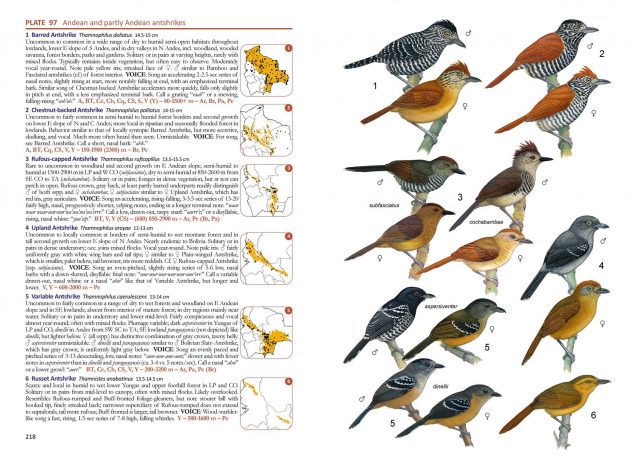
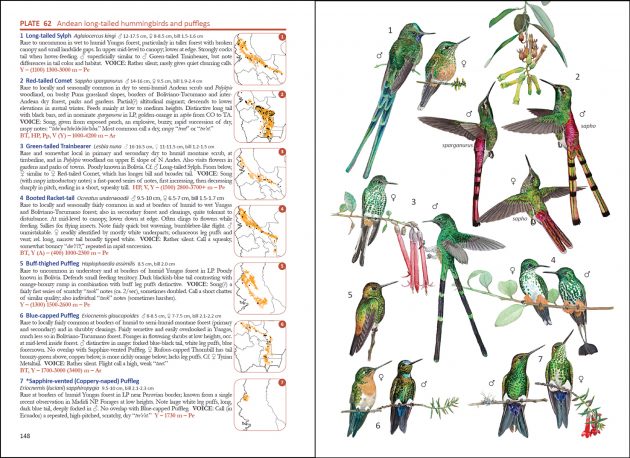
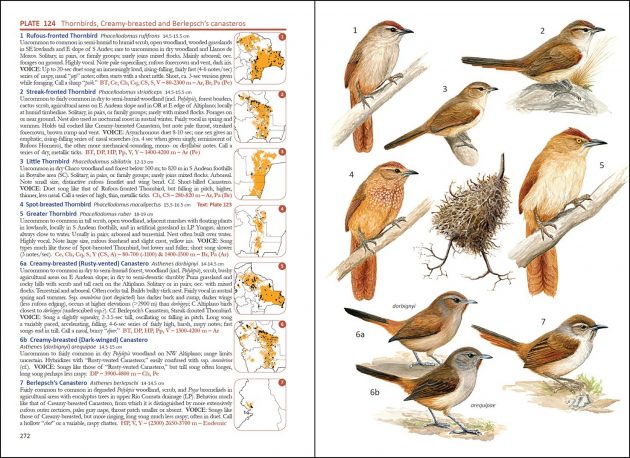
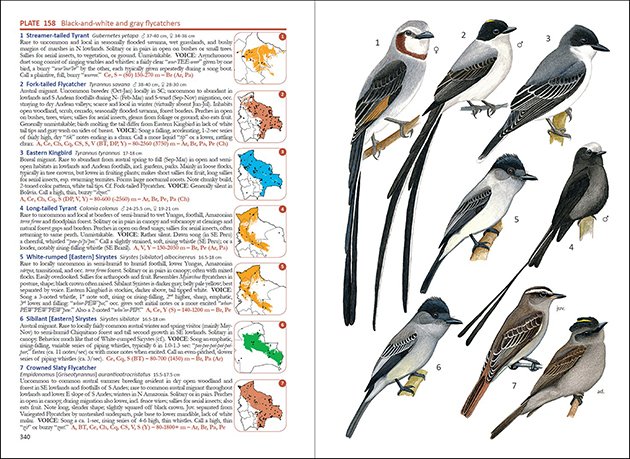











Great review! You inspired field guide lust as well as travel mania. Bolivia is the only country south of the Guianas which I have not spent time in. When Guy Tudor does the main illustration for BSA, it is hard to accept anything less consistently excellent. But I am a fan of several of the “newer” guides (including Jaramillo’s Birds of Chile which did all the images) several of use the multi-artist method. On one visit with Guy, he complained about how long it took to do a volume of that scope. … or was it Bob? 😉
So I expect that the single most complicated portion of these books is the length of time to do the illustrations. and certainly using several artists speeds that up considerably.
Now we can hope for an Argentina guide and for Brett Whitney’s Brazilian guide to finally be completed.!!
Just wondering does anyone read this review before printing because I hope the monies raised go back into Bolivia and not Brazil,
“but for figuring out a publishing mechanism that bypasses commercial publishers and routes profits back into the Brazilian economy for conservation and sustainable development.”
Conor–Thanks for the catch, it’s been corrected. I had a friend who would proofread for me, but she died last year. Sadly, a mind easily confused by countries that begin with B did not catch this (and certainly Spellcheck did not!).
Awesome review of ultimate bolivian birds book. I was secondary illustrator for this field guide, thanks to Sebastian Herzog to the oportunity.
Additionally, I am the main illustrator of the book Endangered birds of the department of Santa Cruz, which I share with you a link
https://www.facebook.com/share/p/PVFm9UwREwDvHDXu/?mibextid=CTbP7E
I also leave my website with some of my illustrations. kind regards from Bolivia!